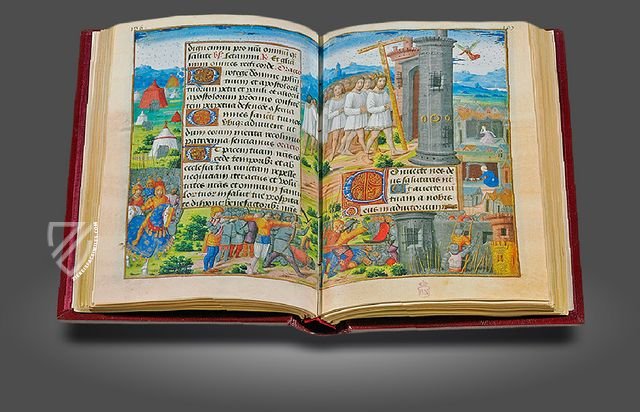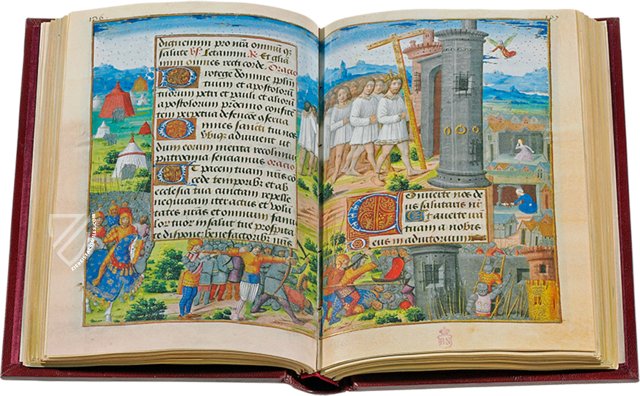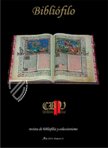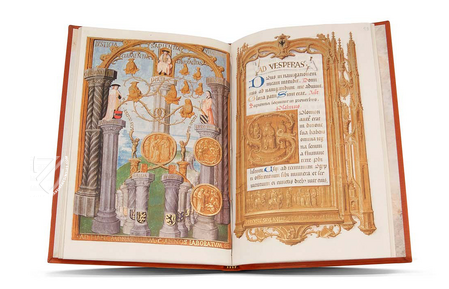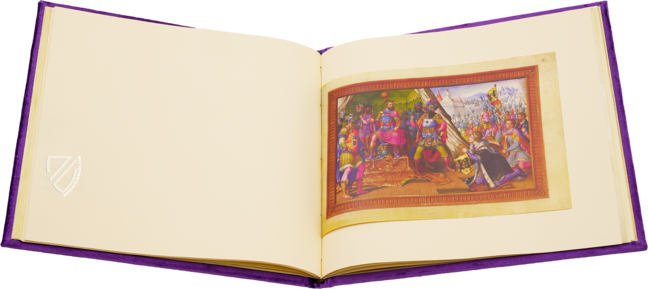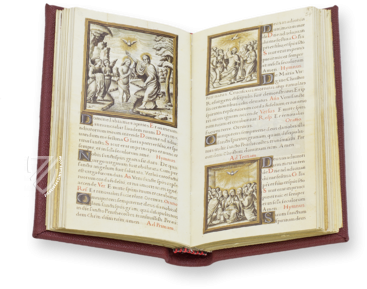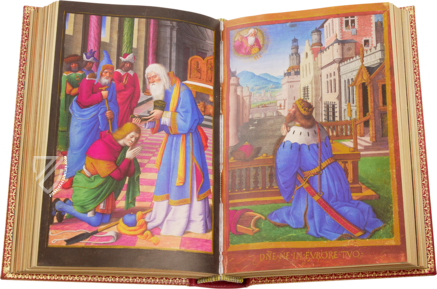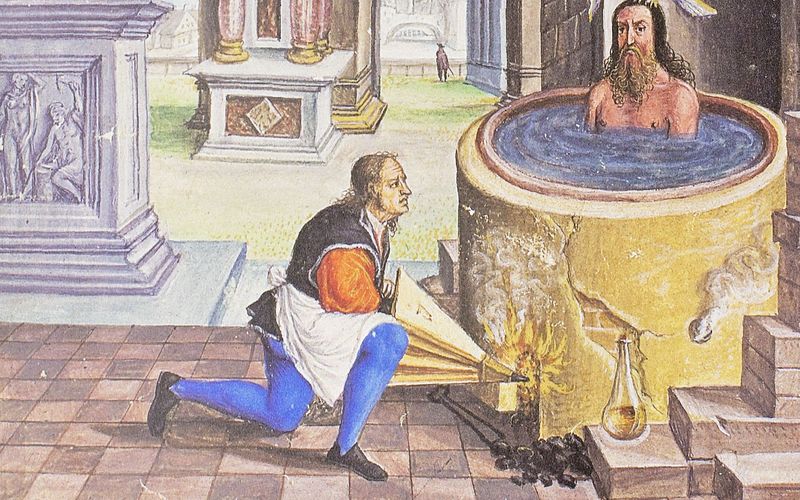Book of Hours of Charles V - Codex Madrid
(3,000€ - 7,000€)
Among the bibliographical treasures exhibited in the Spanish National Library, Cod. Vitr. 24–3 is an exceptionally fine book of hours that belonged to Charles V (1500–58). This manuscript is not just another typical specimen of the countless books of hours produced in the Late Middle Ages and the Renaissance to assist the laity in their devotions, but a work that likely accompanied the powerful monarch on his voyage by sea in 1520 from Spain, where he ruled as King Charles I, to Germany, where he was to be crowned Holy Roman Emperor Charles V.
Book of Hours of Charles V - Codex Madrid
One of the most important codices of the Spanish National Library is Cod. Vitr. 24–3, which was once owned by Emperor Charles V (1500–58), the person who came closest to recreating the universal monarchy of Charlemagne (742–814). A handwritten note on the second page, Hic liber fuit Magni Imperatoris Caroli V, confirms it was owned by him. Created ca. 1503, it may have been intended to be used as a primer for the young prince. A team of artists working under the French master Jean Poyer (d. 1504) is responsible for the incredible work. It may have been created as a gift for the young Charles in the course of marriage negotiations between the Queen of France, Anne of Brittany and Queen Isabella I of Castile. The agreement did not materialize, but the gift remained in Charles’ possession and may have been with him at his imperial coronation in 1520. The manuscript belonged to the Habsburgs until Philip III gave it to Cardinal Francisco de Joyeuse during his visit to Montserrat Monastery. It was part of the library of Cardinal Zelada in the 18th century and entered the Spanish National Library in 1869 along with other codices of the Cathedral of Toledo.
A Renaissance Masterpiece
The codex, written in French bastarda script is, according to Durrie, "A singularly interesting work for the history of illumination." Of its 336 pages, 320 are profusely illustrated with brightly colored full-page miniatures of the highest quality, making this codex an exceptional jewel. The magnificent décor of the manuscript is further embellished by more than 700 historiated initials as well as abundant and varied borders. Its three double-page miniatures – the Victorious Entry of Heraclius in Jerusalem with the Cross of Christ, David's Victory over Goliath, and the Meeting of the Three Death Knights – suffice to qualify the codex as a masterpiece. The manuscript doubles as an encyclopedia because various cycles are interspersed between the biblical stories including the Sibyls, prophets, legends of the True Cross, Marian miracles, Acts of the Apostles, the lives of David and Job, the Dance of Death, etc. This proliferation of images indicates that the manuscript was intended to be seen more than to be read, which broke the established forms for a book of hours. Only a great master like Jean Poyer could have designed and executed such a magnificent manuscript.
The Opulent Image Program
Far from the typical bucolic scenes, the images of the calendar present daily life throughout the months of the year. They do this by tracing the childhood, youth, and maturity of two brothers, one a pious man and the other sinner. Their life cycle ends in December with the former’s soul ascending to Heaven and the latter descending to Hell. This book of hours dedicates 27 miniatures to Genesis (f. 16–42) and each one of them includes a caption – more than many contemporary Bibles. The image cycle of the Life of Christ is presented in 63 miniatures, the Life and Miracles of the Virgin Mary in 20 miniatures, and the Apocalypse in 12 miniatures. With 320 miniatures altogether, this is one of the most richly illuminated manuscripts ever created, made all the more significant because it is the product of one of the greatest ateliers in history: the Parisian workshop of Jean Poyer, which seamlessly blended the predominant artistic styles from Italy and the Netherlands.
Codicology
- Alternative Titles
- Libro de Horas de Carlos V
Stundenbuch Karls V. - Size / Format
- 333 pages / 23.0 × 15.3 cm
- Origin
- France
- Date
- Ca. 1503
- Epochs
- Style
- Genre
- Language
- Script
- Littera bastarda
- Illustrations
- 320 pages nearly completely illuminated with miniatures including 3 double-page miniatures and more than 700 historiated initials
- Content
- Liturgy of the Hours
- Patron
- Charles V, Holy Roman Emperor and King of Spain (1500–1558)
- Artist / School
- Workshop of Jean Poyer
- Previous Owners
- King Philip III of Spain (1578–1621)
Cardinal François de Joyeuse (1562–1615)
Cardinal Francesco Saverio de Zelada (1717–1801)
Book of Hours of Charles V - Codex Madrid
March: Education of Children
While most illustrated medieval calendars show various labors of the month or other bucolic scenes, some, like the one in this extraordinary book of hours, trace human life from beginning to end. Two brothers are usually presented growing up together, one pious and one sinful, who in December find their way to Heaven and Hell, respectively.
Here we see two richly dressed young noblemen: a good pupil standing attentively before the teacher and a bad pupil, sitting off to the side with a board game. There is a remarkable use of space, light, and shadow in the room, which reveals red tile roofed buildings outside. The elegant script is written alternatively in expensive red and blue inks and framed by flowering tendrils backed by gold leaf.
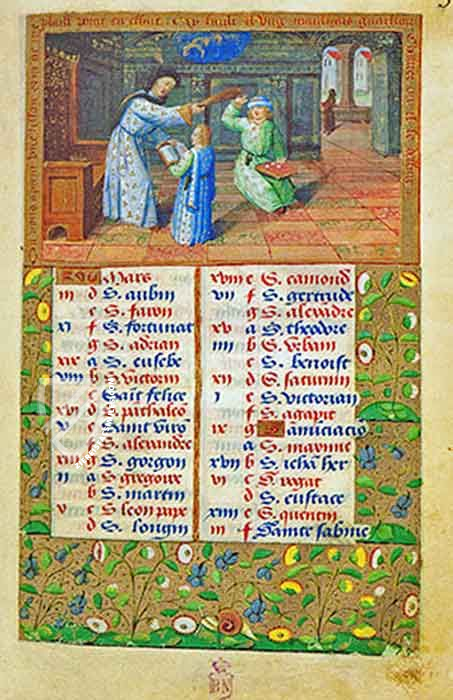
#1 Libro de Horas de Carlos V
Language: Spanish
(3,000€ - 7,000€)
- Treatises / Secular Books
- Apocalypses / Beatus
- Astronomy / Astrology
- Bestiaries
- Bibles / Gospels
- Chronicles / History / Law
- Geography / Maps
- Saints' Lives
- Islam / Oriental
- Judaism / Hebrew
- Single Leaf Collections
- Leonardo da Vinci
- Literature / Poetry
- Liturgical Manuscripts
- Medicine / Botany / Alchemy
- Music
- Mythology / Prophecies
- Psalters
- Other Religious Books
- Games / Hunting
- Private Devotion Books
- Other Genres
- Afghanistan
- Armenia
- Austria
- Belgium
- Belize
- Bosnia and Herzegovina
- China
- Colombia
- Costa Rica
- Croatia
- Cyprus
- Czech Republic
- Denmark
- Egypt
- El Salvador
- Ethiopia
- France
- Germany
- Greece
- Guatemala
- Honduras
- Hungary
- India
- Iran
- Iraq
- Israel
- Italy
- Japan
- Jordan
- Kazakhstan
- Kyrgyzstan
- Lebanon
- Liechtenstein
- Luxembourg
- Mexico
- Morocco
- Netherlands
- Palestine
- Panama
- Peru
- Poland
- Portugal
- Romania
- Russia
- Serbia
- Spain
- Sri Lanka
- Sweden
- Switzerland
- Syria
- Tajikistan
- Turkey
- Turkmenistan
- Ukraine
- United Kingdom
- United States
- Uzbekistan
- Vatican City
- A. Oosthoek, van Holkema & Warendorf
- Aboca Museum
- Ajuntament de Valencia
- Akademie Verlag
- Akademische Druck- u. Verlagsanstalt (ADEVA)
- Aldo Ausilio Editore - Bottega d’Erasmo
- Alecto Historical Editions
- Alkuin Verlag
- Almqvist & Wiksell
- Amilcare Pizzi
- Andreas & Andreas Verlagsbuchhandlung
- Archa 90
- Archiv Verlag
- Archivi Edizioni
- Arnold Verlag
- ARS
- Ars Magna
- ArtCodex
- AyN Ediciones
- Azimuth Editions
- Badenia Verlag
- Bärenreiter-Verlag
- Belser Verlag
- Belser Verlag / WK Wertkontor
- Benziger Verlag
- Bernardinum Wydawnictwo
- BiblioGemma
- Biblioteca Apostolica Vaticana (Vaticanstadt, Vaticanstadt)
- Bibliotheca Palatina Faksimile Verlag
- Bibliotheca Rara
- Boydell & Brewer
- Bramante Edizioni
- Bredius Genootschap
- Brepols Publishers
- British Library
- C. Weckesser
- Caixa Catalunya
- Canesi
- CAPSA, Ars Scriptoria
- Caratzas Brothers, Publishers
- Carus Verlag
- Casamassima Libri
- Centrum Cartographie Verlag GmbH
- Chavane Verlag
- Christian Brandstätter Verlag
- Circulo Cientifico
- Club Bibliófilo Versol
- Club du Livre
- CM Editores
- Collegium Graphicum
- Collezione Apocrifa Da Vinci
- Comissão Nacional para as Comemorações dos Descobrimentos Portugueses
- Coron Verlag
- Corvina
- CTHS
- D. S. Brewer
- Damon
- De Agostini/UTET
- De Nederlandsche Boekhandel
- De Schutter
- Deuschle & Stemmle
- Deutscher Verlag für Kunstwissenschaft
- DIAMM
- Droz
- E. Schreiber Graphische Kunstanstalten
- Ediciones Boreal
- Ediciones Grial
- Ediclube
- Edições Inapa
- Edilan
- Editalia
- Edition Deuschle
- Edition Georg Popp
- Edition Leipzig
- Edition Libri Illustri
- Editiones Reales Sitios S. L.
- Éditions de l'Oiseau Lyre
- Editions Medicina Rara
- Editorial Casariego
- Editorial Mintzoa
- Editrice Antenore
- Editrice Velar
- Edizioni Edison
- Egeria, S.L.
- Eikon Editores
- Electa
- Emery Walker Limited
- Enciclopèdia Catalana
- Eos-Verlag
- Ephesus Publishing
- Ernst Battenberg
- Eugrammia Press
- Extraordinary Editions
- Fackelverlag
- Facsimila Art & Edition
- Facsimile Editions Ltd.
- Facsimilia Art & Edition Ebert KG
- Faksimile Verlag
- Feuermann Verlag
- Folger Shakespeare Library
- Franco Cosimo Panini Editore
- Friedrich Wittig Verlag
- Fundación Hullera Vasco-Leonesa
- G. Braziller
- Gabriele Mazzotta Editore
- Gebr. Mann Verlag
- Gesellschaft für graphische Industrie
- Getty Research Institute
- Giovanni Domenico de Rossi
- Giunti Editore
- Graffiti
- Grafica European Center of Fine Arts
- Guido Pressler
- Guillermo Blazquez
- Gustav Kiepenheuer
- H. N. Abrams
- Harrassowitz
- Harvard University Press
- Helikon
- Hendrickson Publishers
- Henning Oppermann
- Herder Verlag
- Hes & De Graaf Publishers
- Hoepli
- Holbein-Verlag
- Houghton Library
- Hugo Schmidt Verlag
- Idion Verlag
- Il Bulino, edizioni d'arte
- ILte
- Imago
- Insel Verlag
- Insel-Verlag Anton Kippenberger
- Instituto de Estudios Altoaragoneses
- Instituto Nacional de Antropología e Historia
- Introligatornia Budnik Jerzy
- Istituto dell'Enciclopedia Italiana - Treccani
- Istituto Ellenico di Studi Bizantini e Postbizantini
- Istituto Geografico De Agostini
- Istituto Poligrafico e Zecca dello Stato
- Italarte Art Establishments
- Jan Thorbecke Verlag
- Johnson Reprint Corporation
- Josef Stocker
- Josef Stocker-Schmid
- Jugoslavija
- Karl W. Hiersemann
- Kasper Straube
- Kaydeda Ediciones
- Kindler Verlag / Coron Verlag
- Kodansha International Ltd.
- Konrad Kölbl Verlag
- Kurt Wolff Verlag
- La Liberia dello Stato
- La Linea Editrice
- La Meta Editore
- Lambert Schneider
- Landeskreditbank Baden-Württemberg
- Leo S. Olschki
- Les Incunables
- Liber Artis
- Library of Congress
- Libreria Musicale Italiana
- Lichtdruck
- Lito Immagine Editore
- Lumen Artis
- Lund Humphries
- M. Moleiro Editor
- Maison des Sciences de l'homme et de la société de Poitiers
- Manuscriptum
- Martinus Nijhoff
- Maruzen-Yushodo Co. Ltd.
- MASA
- Massada Publishers
- McGraw-Hill
- Metropolitan Museum of Art
- Militos
- Millennium Liber
- Müller & Schindler
- Nahar - Stavit
- Nahar and Steimatzky
- National Library of Wales
- Neri Pozza
- Nova Charta
- Oceanum Verlag
- Odeon
- Orbis Mediaevalis
- Orbis Pictus
- Österreichische Staatsdruckerei
- Oxford University Press
- Pageant Books
- Parzellers Buchverlag
- Patrimonio Ediciones
- Pattloch Verlag
- PIAF
- Pieper Verlag
- Plon-Nourrit et cie
- Poligrafiche Bolis
- Presses Universitaires de Strasbourg
- Prestel Verlag
- Princeton University Press
- Prisma Verlag
- Priuli & Verlucca, editori
- Pro Sport Verlag
- Propyläen Verlag
- Pytheas Books
- Quaternio Verlag Luzern
- Reales Sitios
- Recht-Verlag
- Reichert Verlag
- Reichsdruckerei
- Reprint Verlag
- Riehn & Reusch
- Roberto Vattori Editore
- Rosenkilde and Bagger
- Roxburghe Club
- Salerno Editrice
- Saltellus Press
- Sandoz
- Sarajevo Svjetlost
- Schöck ArtPrint Kft.
- Schulsinger Brothers
- Scolar Press
- Scrinium
- Scripta Maneant
- Scriptorium
- Shazar
- Siloé, arte y bibliofilia
- SISMEL - Edizioni del Galluzzo
- Sociedad Mexicana de Antropología
- Société des Bibliophiles & Iconophiles de Belgique
- Soncin Publishing
- Sorli Ediciones
- Stainer and Bell
- Studer
- Styria Verlag
- Sumptibus Pragopress
- Szegedi Tudomànyegyetem
- Taberna Libraria
- Tarshish Books
- Taschen
- Tempus Libri
- Testimonio Compañía Editorial
- Thames and Hudson
- The Clear Vue Publishing Partnership Limited
- The Facsimile Codex
- The Folio Society
- The Marquess of Normanby
- The Richard III and Yorkist History Trust
- Tip.Le.Co
- TouchArt
- TREC Publishing House
- TRI Publishing Co.
- Trident Editore
- Tuliba Collection
- Typis Regiae Officinae Polygraphicae
- Union Verlag Berlin
- Universidad de Granada
- University of California Press
- University of Chicago Press
- Urs Graf
- Vallecchi
- Van Wijnen
- VCH, Acta Humaniora
- VDI Verlag
- VEB Deutscher Verlag für Musik
- Verlag Anton Pustet / Andreas Verlag
- Verlag Bibliophile Drucke Josef Stocker
- Verlag der Münchner Drucke
- Verlag für Regionalgeschichte
- Verlag Styria
- Vicent Garcia Editores
- W. Turnowski Ltd.
- W. Turnowsky
- Waanders Printers
- Wiener Mechitharisten-Congregation (Wien, Österreich)
- Wissenschaftliche Buchgesellschaft
- Wissenschaftliche Verlagsgesellschaft
- Wydawnictwo Dolnoslaskie
- Xuntanza Editorial
- Zakład Narodowy
- Zollikofer AG

